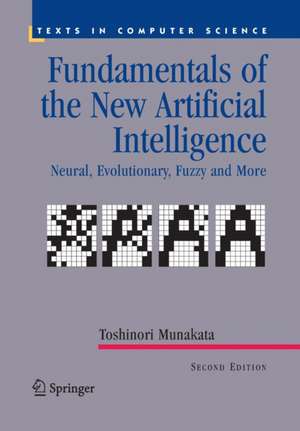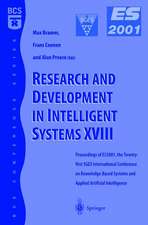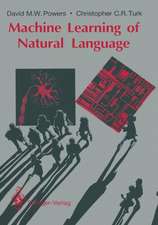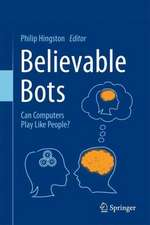Fundamentals of the New Artificial Intelligence: Neural, Evolutionary, Fuzzy and More: Texts in Computer Science
Autor Toshinori Munakataen Limba Engleză Paperback – 21 feb 2008
New sections/subsections added in this edition are: Simulated Annealing (Section 3.7), Boltzmann Machines (Section 3.8) and Extended Fuzzy if-then Rules Tables (Sub-section 5.5.3). Also, numerous changes and typographical corrections have been made throughout the manuscript. The Preface to the first edition follows. General scope of the book Artificial intelligence (AI) as a field has undergone rapid growth in diversification and practicality. For the past few decades, the repertoire of AI techniques has evolved and expanded. Scores of newer fields have been added to the traditional symbolic AI. Symbolic AI covers areas such as knowledge-based systems, logical reasoning, symbolic machine learning, search techniques, and natural language processing. The newer fields include neural networks, genetic algorithms or evolutionary computing, fuzzy systems, rough set theory, and chaotic systems.
| Toate formatele și edițiile | Preț | Express |
|---|---|---|
| Paperback (1) | 532.04 lei 6-8 săpt. | |
| SPRINGER LONDON – 21 feb 2008 | 532.04 lei 6-8 săpt. | |
| Hardback (1) | 536.66 lei 6-8 săpt. | |
| SPRINGER LONDON – 21 feb 2008 | 536.66 lei 6-8 săpt. |
Din seria Texts in Computer Science
- 20%
 Preț: 406.21 lei
Preț: 406.21 lei - 20%
 Preț: 370.59 lei
Preț: 370.59 lei - 20%
 Preț: 411.53 lei
Preț: 411.53 lei - 20%
 Preț: 417.80 lei
Preț: 417.80 lei - 20%
 Preț: 306.37 lei
Preț: 306.37 lei - 20%
 Preț: 411.75 lei
Preț: 411.75 lei - 20%
 Preț: 1244.39 lei
Preț: 1244.39 lei - 20%
 Preț: 503.88 lei
Preț: 503.88 lei - 20%
 Preț: 444.93 lei
Preț: 444.93 lei - 20%
 Preț: 474.58 lei
Preț: 474.58 lei - 20%
 Preț: 305.31 lei
Preț: 305.31 lei - 20%
 Preț: 675.36 lei
Preț: 675.36 lei - 20%
 Preț: 423.53 lei
Preț: 423.53 lei - 20%
 Preț: 441.71 lei
Preț: 441.71 lei -
 Preț: 506.24 lei
Preț: 506.24 lei - 20%
 Preț: 366.94 lei
Preț: 366.94 lei - 20%
 Preț: 370.23 lei
Preț: 370.23 lei - 20%
 Preț: 515.36 lei
Preț: 515.36 lei - 15%
 Preț: 637.58 lei
Preț: 637.58 lei - 20%
 Preț: 353.34 lei
Preț: 353.34 lei - 20%
 Preț: 356.82 lei
Preț: 356.82 lei - 20%
 Preț: 181.92 lei
Preț: 181.92 lei - 20%
 Preț: 330.42 lei
Preț: 330.42 lei - 20%
 Preț: 743.62 lei
Preț: 743.62 lei - 20%
 Preț: 663.45 lei
Preț: 663.45 lei -
 Preț: 457.75 lei
Preț: 457.75 lei - 20%
 Preț: 536.66 lei
Preț: 536.66 lei -
 Preț: 385.84 lei
Preț: 385.84 lei - 20%
 Preț: 358.24 lei
Preț: 358.24 lei - 20%
 Preț: 394.57 lei
Preț: 394.57 lei - 20%
 Preț: 344.76 lei
Preț: 344.76 lei - 20%
 Preț: 621.18 lei
Preț: 621.18 lei - 20%
 Preț: 350.86 lei
Preț: 350.86 lei - 20%
 Preț: 348.89 lei
Preț: 348.89 lei - 20%
 Preț: 339.95 lei
Preț: 339.95 lei - 20%
 Preț: 588.21 lei
Preț: 588.21 lei - 20%
 Preț: 199.57 lei
Preț: 199.57 lei - 20%
 Preț: 341.30 lei
Preț: 341.30 lei - 23%
 Preț: 726.94 lei
Preț: 726.94 lei - 20%
 Preț: 325.30 lei
Preț: 325.30 lei - 20%
 Preț: 595.80 lei
Preț: 595.80 lei - 20%
 Preț: 593.48 lei
Preț: 593.48 lei -
 Preț: 454.31 lei
Preț: 454.31 lei
Preț: 532.04 lei
Preț vechi: 665.05 lei
-20% Nou
Puncte Express: 798
Preț estimativ în valută:
101.84€ • 110.66$ • 85.60£
101.84€ • 110.66$ • 85.60£
Carte tipărită la comandă
Livrare economică 21 aprilie-05 mai
Preluare comenzi: 021 569.72.76
Specificații
ISBN-13: 9781447168034
ISBN-10: 1447168038
Pagini: 256
Ilustrații: XI, 256 p.
Dimensiuni: 168 x 240 x 14 mm
Greutate: 0.44 kg
Ediția:2nd ed. 2008
Editura: SPRINGER LONDON
Colecția Springer
Seria Texts in Computer Science
Locul publicării:London, United Kingdom
ISBN-10: 1447168038
Pagini: 256
Ilustrații: XI, 256 p.
Dimensiuni: 168 x 240 x 14 mm
Greutate: 0.44 kg
Ediția:2nd ed. 2008
Editura: SPRINGER LONDON
Colecția Springer
Seria Texts in Computer Science
Locul publicării:London, United Kingdom
Cuprins
Neural Networks: Fundamentals and the Backpropagation Model.- Neural Networks: Other Models.- Genetic Algorithms and Evolutionary Computing.- Fuzzy Systems.- Rough Sets.- Chaos.
Recenzii
From the reviews of the second edition:
"The book focuses on five important areas in computer science: neural networks, genetic algorithms, fuzzy systems, rough sets, and chaos. … This is an excellent textbook for undergraduate and graduate students in computer science, coming to this subject for the first time and desiring to acquire a comprehensive view of the whole area of soft computing. The mathematical background required is minimal … . Critical comparisons among the models illustrated are suggested, and essential literature references are given for further reading." (G. Guida, ACM Computing Reviews, October, 2008)
"The book focuses on five important areas in computer science: neural networks, genetic algorithms, fuzzy systems, rough sets, and chaos. … This is an excellent textbook for undergraduate and graduate students in computer science, coming to this subject for the first time and desiring to acquire a comprehensive view of the whole area of soft computing. The mathematical background required is minimal … . Critical comparisons among the models illustrated are suggested, and essential literature references are given for further reading." (G. Guida, ACM Computing Reviews, October, 2008)
Textul de pe ultima copertă
Artificial intelligence—broadly defined as the study of making computers perform tasks that require human intelligence—has grown rapidly as a field of research and industrial application in recent years. Whereas traditionally, AI used techniques drawn from symbolic models such as knowledge-based and logic programming systems, interest has grown in newer paradigms, notably neural networks, genetic algorithms, and fuzzy logic.
The significantly updated second edition of Fundamentals of the New Artificial Intelligence thoroughly covers the most essential and widely employed material pertaining to neural networks, genetic algorithms, fuzzy systems, rough sets, and chaos. In particular, this unique textbook explores the importance of this content for real-world applications. The exposition reveals the core principles, concepts, and technologies in a concise and accessible, easy-to-understand manner, and as a result, prerequisites are minimal: A basic understanding of computer programming and mathematics makes the book suitable for readers coming to this subject for the first time.
Topics and features:
• Emphasizes the real-world applications derived from this important area of computer science
• Provides easy-to-comprehend descriptions and algorithms
• Updates all references, for maximum usefulness to professors, students, and other readers [NEW]
• Integrates all material, yet allows each chapter to be used or studied independently
This invaluable textand reference is an authoritative introduction to the subject and is therefore ideal for upper-level undergraduates and graduates studying intelligent computing, soft computing, neural networks, evolutionary computing, and fuzzy systems. In addition, the material is self-contained and therefore valuable to researchers in many related disciplines. Professor Munakata is a leading figure in this field and has given courses on this topic extensively.
The significantly updated second edition of Fundamentals of the New Artificial Intelligence thoroughly covers the most essential and widely employed material pertaining to neural networks, genetic algorithms, fuzzy systems, rough sets, and chaos. In particular, this unique textbook explores the importance of this content for real-world applications. The exposition reveals the core principles, concepts, and technologies in a concise and accessible, easy-to-understand manner, and as a result, prerequisites are minimal: A basic understanding of computer programming and mathematics makes the book suitable for readers coming to this subject for the first time.
Topics and features:
- Retains the well-received features of the first edition, yet clarifies and expands on the topic
• Emphasizes the real-world applications derived from this important area of computer science
• Provides easy-to-comprehend descriptions and algorithms
• Updates all references, for maximum usefulness to professors, students, and other readers [NEW]
• Integrates all material, yet allows each chapter to be used or studied independently
This invaluable textand reference is an authoritative introduction to the subject and is therefore ideal for upper-level undergraduates and graduates studying intelligent computing, soft computing, neural networks, evolutionary computing, and fuzzy systems. In addition, the material is self-contained and therefore valuable to researchers in many related disciplines. Professor Munakata is a leading figure in this field and has given courses on this topic extensively.
Caracteristici
No other books emphasize technical fundamentals of newer AI areas New sections, such as that on Boltzmann Machines, contain easy-to-understand descriptions and algorithms, following the features on the original edition

















